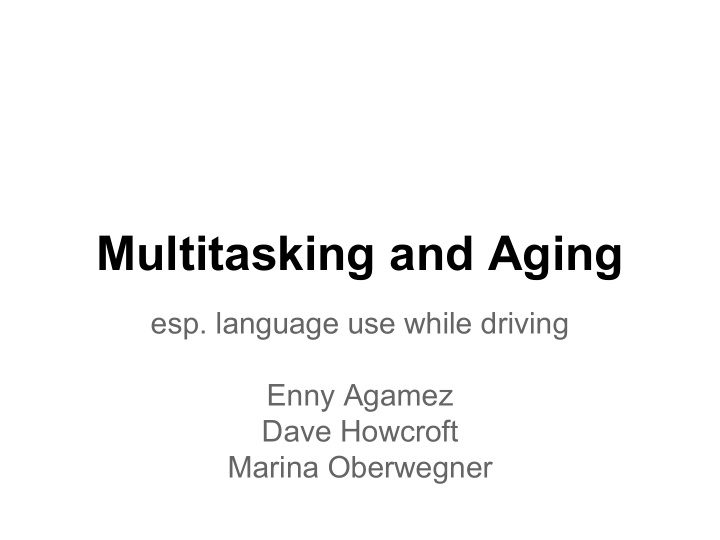



Multitasking and Aging esp. language use while driving Enny Agamez Dave Howcroft Marina Oberwegner
Dual-Tasking + Aging A variety of papers published arguing both sides: aging does / does not affect multitasking. Verhaegen et al. 2003 meta-study ● Older adults are slower than predicted from general slowing. ● But their accuracy remains the same.
Dual-Tasking + Driving ...to the PDF!
Cell phones + Driving We expect this to be more dangerous. From Strayer & Drews 2007* ● inattention blindness: failure to react to visible objects ● tunnel vision: less scanning ● drivers are slower to react when distracted ● on the phone ⇒ EEG activity associated with driving reduced * adapted from Vera's slides in lecture 3
Cell phones + Driving* Recall that… ● passengers adapt ○ talking less (Crundall et al. 2005) ○ with reduced complexity (Drews et al. 2008) ● linguistic complexity matters (Demberg et al. 2013) * adapted from Vera's slides in lecture 3
Cell phones + Driving + Aging What do you expect? Older and younger adults show the same amount of slowing when dual-tasking . But older adults are also slower and leave greater following distances in general. Strayer & Drews. 2004. "Profiles in Driver Distraction: Effects of Cell Phone Conversations on Younger and Older Drivers".
Strayer & Drews 2004: the sample Younger Older ● age: 20.2 yrs ● 69.6 yrs ● N: 20 (13m; 7f) ● 20 (14m; 6f) ● schooling: 9.6 yrs ● 15.5 yrs ● digit symbol: 84.6 ● 59.1 ● maze tracing: 15.1 ● 8.1 And we stick them in a simulator one at a time!
Strayer & Drews 2004: the task Follow a pace car on the highway. Brake when the pace car brakes. (in dual-task condition) converse with an RA.
Strayer & Drews 2004: the analysis 2x2 factorial design Statistics ● age (young vs. old) ● M ultivariate ● task (single vs. AN alysis dual) O f VA riance ● Split-Plot ANOVA Dependent Variables on individual dep. ● brake onset time var.s ● following distance ● significance level at ● driving speed p < 0.05
Strayer & Drews 2004: the results Dependent Var.s Age Tasking Age x Tasking Brake onset time p ≈ 0.08 dual → slower braking p > 0.64 Following distance p ≈ 0.06 p > 0.98 old → larger distance p > 0.97 p > 0.22 Speed old → lower speed COMBINED p < 0.01 p < 0.01 p > 0.23 dual-tasking leads to more accidents (p < 0.02)
Strayer & Drews 2004: time course
Strayer & Drews 2004: time course
Strayer & Drews 2004: conclusion Effect of cell phone use on driving is the same for older and for younger adults. But older adults are generally slower and leave greater following distances.
Video game training enhances cognitive control in older adults
Cognitive Control
Cognitive Control • • • •
Multitasking • →
Participants
Video game design • • • • •
Video game design • •
Experiment 1
Experiment 1 •
Experiment 1 - Results • • •
Experiment 2
Video game training enhances cognitive control in older adults
Experiment 2 • • • • • •
Experiment 2 •
Experiment 2 - Results • •
Experiment 2 - Results → • • →
Experiment 2 - Results → • • → →
Experiment 2 - Results • •
Summary • • • →
Summary
Summary: Talking, Driving, Aging What do we know? What can we do?
Discussion Questions Are these really age-related differences? Or differences in working memory, etc? If you're leaving a larger following distance, doesn't it make sense to have a less abrupt deceleration? Might the older adult's performance in Aksan et al. (2012) be a result of better discriminative modeling / memory à la Ramscar.
Discussion Questions How useful might cognitive training be in the long-term view? What do you think about the result that older people improved to the level of the 20 years old in performance?
References Aksan, Nazan, Jeffrey D. Dawson, Jamie L. Emerson, Lixi Yu, Ergun Y. Uc, Steven W. Anderson, & Matthew Rizzo. (2012). "Naturalistic Distraction and Driving Safety in Older Drivers". Human Factors , 55(4), 841-853. Anguera, J. A., J. Boccanfuso, J. L. Rintoul, O. Al-Hashimi, F. Faraji, J. Janowich, E. Kong, Y. Larraburo, C. Rolle, E. Johnston, & A. Gazzaley. (2013). "Video game training enhances cognitive control in older adults". Nature , 501(7465), 97-101. Demberg, Vera, Asad Sayeed, Angela Mahr, & Christian Müller. (2013). "Measuring linguistically- induced cognitive load during driving using the ConTRe task". In Proceedings of the 5th International Conference on Automotive User Interfaces and Interactive Vehicular Applications (AutoUI) , Eindhoven, The Netherlands. Strayer, David L., & Frank A. Drews. (2004). "Profiles in Driver Distraction: Effects of Cell Phone Conversations on Younger and Older Drivers". Human Factors , 46(4): 640-649. Verhaegen, Paul, David W. Steitz, Martin J. Sliwinski, & John Cerella. (2003). "Aging and dual-task performance: a meta-analysis". Psychology and Aging , 18(3): 443-460.
Further Reading Gaspar, John G., Whitney N. Street, Matthew B. Windsor, Ronald Carbonari, Henry Kaczmarski, Arthur F. Kramer, & Kyle E. Mathewson. (2014). "Providing Views of the Driving Scene to Drivers’ Conversation Partners Mitigates Cell-Phone-Related Distraction". Psychological Science , 25(12): 2136-2146.
Additional temporal profiles
Additional temporal profiles
Recommend
More recommend